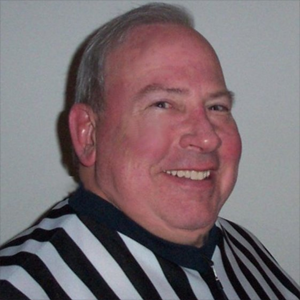
Rndballref
20 Years Experience
Chicago, IL
Male, 60
For twenty years I officiated high school, AAU and park district basketball games, retiring recently. For a few officiating is the focus of their occupation, while for most working as an umpire or basketball referee is an avocation. I started ref'ing to earn beer money during college, but it became a great way to stay connected to the best sports game in the universe. As a spinoff, I wrote a sports-thriller novel loosely based on my referee experiences titled, Advantage Disadvantage
If the ball goes over the top of a rectangular backboard in either direction it is out of bounds.
If the ball goes over the top of a fan backboard it stays in play.
There are no specifications in the rule book as to when a referee asks home management to eject a fan. It is very subjective, and it does not have to have a warning. I drew the line at personal attacks - to another fan, the other team, my partners, or to me. I never minded if fans boo'd my calls, but as soon as it got personal or vial, that's when I had someone ejected.
Let's stop beating around the bush here. Tell me what you did to get tossed out of your son or daughter's game.
I know the NFHS rules but I found this online from SB Nation regarding college reviews:
...now the following types of plays will be eligible:
shot clock violations in final 2 minutes or overtime
out of bounds plays in final 2 minutes or overtime
two point vs three points
which player committed a called foul (to make sure the correct player is assessed)
flagrant foul calls
NOTE: this list does not include intentional so if this correct it would seem to be excluded. maybe someone can post a more definitive answer?
The ball should be spotted at a point near the foul. It only comes back to the original thrown if it is not touched or there are no fouls called before the ball is out of bounds.
Pharmaceutical Researcher
 Is there or isn't there a cure for AIDS?
Is there or isn't there a cure for AIDS?
Claims Adjuster
Casino Dealer
 Do you find casinos to be depressing places to work?
Do you find casinos to be depressing places to work?
The assignment chairperson should never entertain your tape. Your coach probably tapes the games and the coach (or athletic director) should deal with the quality of the officiating. In my opinion you are getting in too deep, without a real understanding of how the officials are trained. For example, they may see what you are yelling about but they may be making an "Advantage Disadvantage" judgement (this is discussed in a previous question).
The dribble ends when the ball is knocked away, and so does player possession. So, if you pick up the ball and dribble it is not double dribble. You can pick up a ball with two hands as long as you are lifting up. If you push down with two hands it is double dribble.
A legal screen can only be set when the screener is stationary, except when both players are moving in the same direction. So, because you have not stopped (become stationary) it seems like it is an illegal screen UNLESS you are both moving in the same direction, he is behind you, and as you slow down he runs into you.
-OR-
 Login with Facebook
Login with Facebook (max 20 characters - letters, numbers, and underscores only. Note that your username is private, and you have the option to choose an alias when asking questions or hosting a Q&A.)
(A valid e-mail address is required. Your e-mail will not be shared with anyone.)
(min 5 characters)
By checking this box, you acknowledge that you have read and agree to Jobstr.com’s Terms and Privacy Policy.
-OR-
 Register with Facebook
Register with Facebook(Don't worry: you'll be able to choose an alias when asking questions or hosting a Q&A.)